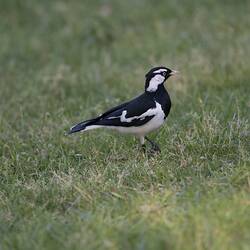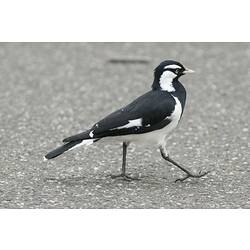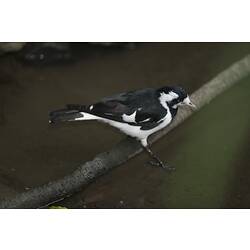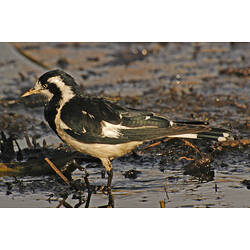General Description
Body black and white. Males have a black throat and white eyebrow, females have a white throat and no eyebrow. Bill thin and white. Bill to tail length up to 30 cm. Call a distinctive 'pee wee' or "pee-o-wit" from which one of their common names, Peewee, comes. They look similar to Australian Magpies, Cracticus tibicen, but are much smaller.
Biology
Magpie-larks often call in pairs, raising and lowering their wings in unison with the song. They establish territories up to 10 hectares in size. These territories are aggressively defended, with Magpie-larks attacking much larger birds including Wedge-tailed Eagles, Aquila audax. Both the male and female help to construct the bowl-shaped nest, which is made of wet mud built onto a horizontal branch. They line the nest with grasses, hair and feathers. Usual clutch size is three to five eggs and they can produce multiple clutches if conditions are favourable. Magpie-larks forage on the ground, walking slowly in search of food. The feed on invertebrates including insects, insect larvae and earthworms. Magpie-larks can form large nomadic flocks, migrating south in the summer and north in the winter. They often call in pairs, raising their wings in unison with the song.
Distribution
Southern New Guinea and Timor. Mainland Australia except Gibson and Great Victoria Deserts.
Habitat
Most habitats, including urban areas, except dense forests and very arid deserts.
More Information
-
Animal Type
-
Animal SubType
-
Brief Id
Black and white bird with white bill.
-
Colours
Black, White
-
Maximum Size
30 cm
-
Habitats
Wetland, Urban, DryForest, WetForest, Woodland, Mallee, Grassland
-
Diet
Insects
-
Endemicity
-
Commercial
No
-
Conservation Statuses
CITES: Not listed, FFG Threatened List: Not listed, EPBC Act 1999: Not listed, IUCN Red List: Least Concern
-
Taxon Name
-
Common Name
Magpie-lark
-
Other Names
Mudlark , Peewee
-
Kingdom
-
Phylum
-
Subphylum
-
Class
-
Order
-
Family
-
Genus
-
Species Name
cyanoleuca









